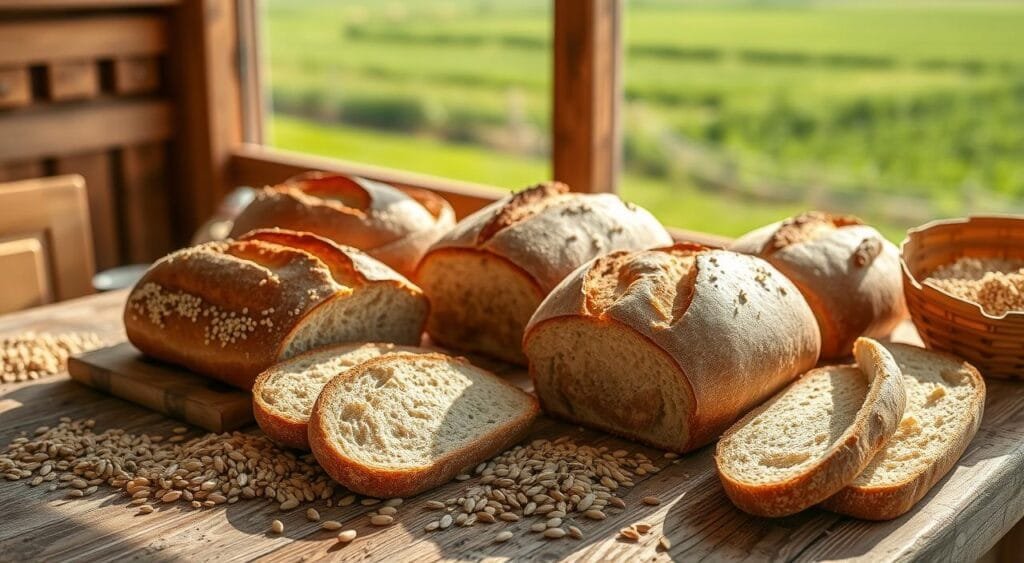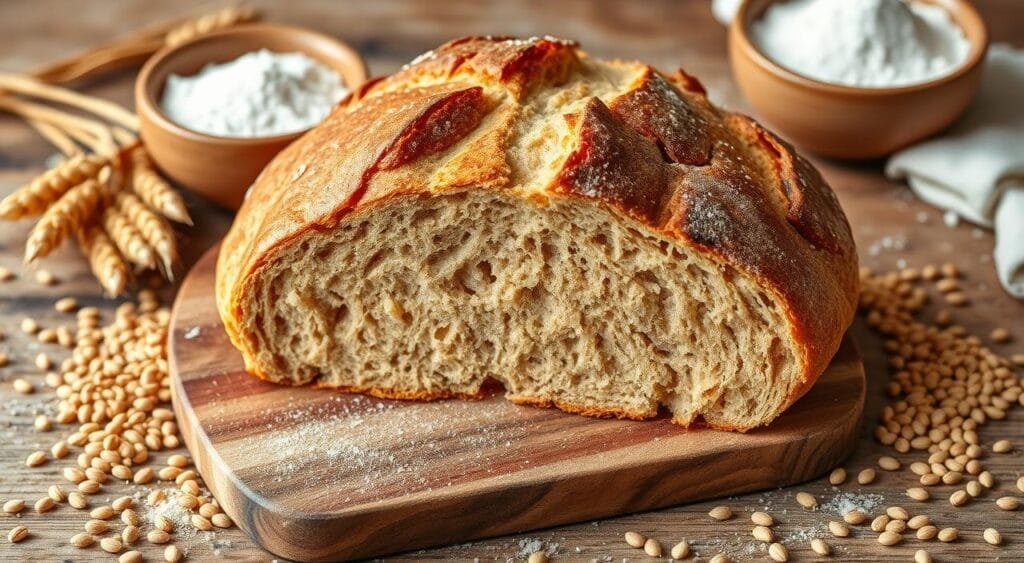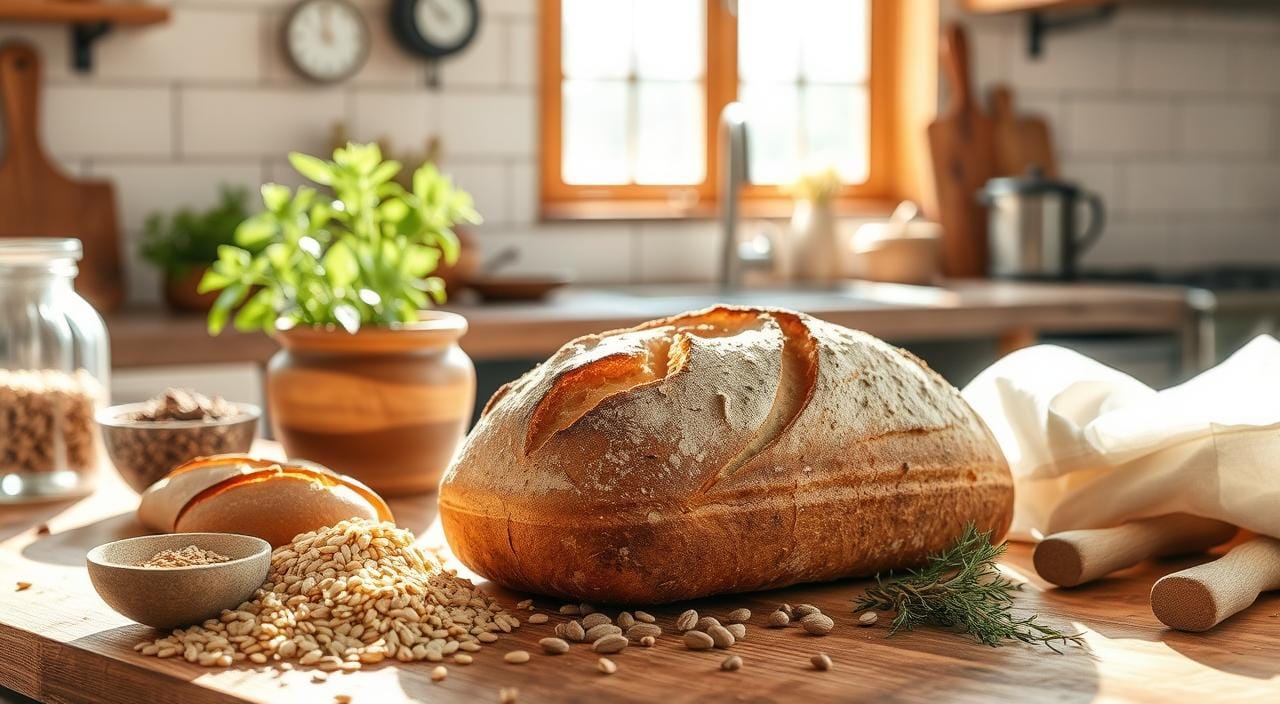As a busy parent, I know how crucial it is to feed your family well. That’s why I’m thrilled to share the magic of fresh organic bread. Imagine cutting into a loaf full of unbleached wheat flour, organic coconut oil, and natural apple cider vinegar. This bread not only feeds your body but also tickles your taste buds.
Unlike the processed breads in stores, organic bread is a healthier choice. It’s made with care and shipped fresh to your home. This ensures you and your family enjoy top-notch quality and taste.
Whether you’re making grilled cheese or French toast, this bread will make your dishes better. Enjoy the soft, chewy texture, knowing you’re giving your family the best. Make the switch to fresh, organic bread for a healthier future.
Understanding the Benefits of Organic Bread
Organic bread is better than regular bread in many ways. It’s made with non-GMO flour and natural ingredients. This means it’s healthier for you and better for the planet. Unlike regular bread, organic bread doesn’t have harmful additives.
Health Advantages of Natural Ingredients
Organic bread comes from organic grains grown without bad chemicals. This makes it full of good stuff like vitamins and fiber. Eating organic bread can help you feel full longer, which is good for your weight.
The way organic sourdough bread is made also adds fiber and probiotics. These are great for your gut health.
Environmental Impact of Organic Farming
Making organic organic bread is better for the planet than regular bread. Organic farming keeps the soil healthy and stops erosion. It also doesn’t harm animals or the environment.
Quality Differences from Conventional Bread
Organic bread tastes and feels better than regular bread. The non-GMO flour used in organic bread is of higher quality. Without artificial additives, organic bread tastes more natural and satisfying.

Essential Ingredients for Wholesome Bread Making
Creating delicious and healthy bread starts with the right ingredients. Whole wheat bread lovers know that using natural ingredients is key. Ingredients like organic unbleached wheat flour, organic coconut oil, and apple cider vinegar are crucial. They help make a bread that’s good for you and tastes great.
Whole wheat flour is a main ingredient in wholesome bread. It’s different from white flour because it keeps the whole grain’s nutrients. This makes the bread full of fiber, keeping you satisfied. Organic coconut oil and apple cider vinegar add flavor and make the bread soft, without any artificial stuff.
Adding non-GMO flours like organic flaxmeal or organic evaporated cane juice boosts the bread’s nutrition. These ingredients add fiber and minerals, and a hint of sweetness. This makes the bread not only tasty but also healthy.

Using these whole wheat bread ingredients lets you make a loaf that’s both tasty and healthy. Baking with natural ingredients brings out the best in homemade bread. It makes sure every slice is a healthy choice for your family.
The Science Behind Fresh Organic Bread Production
Creating tasty artisan bread and sourdough bread is a fascinating science. At its core is the complex fermentation process. This process adds flavor and makes the bread healthier.
Fermentation Process
Yeast fermentation is key in making commercial bread. Yeast breaks down sugars in the dough. It produces carbon dioxide for rise and alcohol for flavor.
This process takes hours. It lets the flavors mature and the dough rise perfectly.
Temperature Control and Timing
Keeping the right temperature is vital in bread-making. Yeast needs warmth, between 75°F and 85°F (24°C to 29°C), to work well. The type of flour and how much water used also affect fermentation.
Whole-grain flour ferments faster. This is because it has more enzymes and nutrients.
Natural Preservation Methods
Organic bread makers use natural ways to keep bread fresh. They use apple cider vinegar to stop mold and spoilage. This way, bread stays fresh longer without artificial additives.
The science of making fresh organic bread is a blend of fermentation, temperature control, and natural preservation. This careful method makes delicious and healthy bread. It also supports a sustainable baking industry.
Nutritional Profile of Organic Bread Varieties
Choosing the healthiest bread means looking at organic options. Whole wheat bread has 3-5g of protein and 2-4g of fiber per slice. It’s filling and packed with nutrients. Multigrain breads add vitamins and minerals from different grains and seeds.
When picking organic bread, look for 2-3g or less of added sugar per slice. Also, aim for at least 3g of protein. This ensures you’re getting the best from healthy baking ingredients. The USDA suggests eating 6 servings of grains a day, with half being whole grains. Organic bread can help you meet this goal.
“Organic” bread must contain at least 95% organic ingredients by weight, while “Made with organic ingredients” bread needs to have at least 70% organic ingredients.
Not all organic breads are the same. “Organic” is regulated, but “natural” is not. This means different meanings for different products. Reading labels and understanding ingredients helps you make better choices for your health.
Choosing the Best Store-Bought Organic Bread
When picking organic bread, don’t just look at the label. Check the ingredients for quality. Make sure “whole” is the first ingredient. Stay away from breads with partially hydrogenated oils or high fructose corn syrup.
Reading Product Labels
Look at the nutrition facts on the bread package. Choose bread with 2-3 grams of fiber and 3 grams of protein per slice. Also, aim for less than 2-3 grams of added sugar per slice.
Understanding Ingredient Lists
Clean eating fans suggest picking whole wheat bread with organic whole wheat flour first. Options like Nature’s Own 100% Whole Wheat, Sara Lee 100% Whole Wheat, and Dave’s Killer Bread Powerseed are good choices. They offer great taste and nutrition.
Price Comparison Guide
Organic bread prices vary. The most expensive isn’t always the best. Compare nutritional values and ingredients to find affordable, quality whole wheat bread.
Storage and Freshness Tips
Keeping your artisan bread fresh is key, especially for preservative-free organic loaves. Store your bread at room temperature in a sealed bag or container. This helps keep its moisture and texture.
In warmer weather, bread can mold faster without preservatives. To keep your bread fresh longer, freeze it. Frozen bread can stay fresh for up to 3 months or more. Just thaw it at room temperature or toast it from the freezer.
“The balance of moisture and air circulation is crucial in preserving bread freshness. Excess air can lead to stale bread quickly.”
For sandwich bread or larger boules, use large, food-grade plastic bags. This keeps the right moisture and air balance. It prevents your bread from drying out or getting stale too fast.
Sourdough bread, with its natural enzymes and bacteria, stays fresh longer. The acid from the sourdough starter slows down staling. This lets a loaf stay edible for a week or more.
By following these tips, you can enjoy your preservative-free organic bread for days. A little care lets you savor the wholesome goodness of your artisan loaves for longer.
Organic Bread for Special Dietary Needs
Organic bread is a treasure trove for those with special dietary needs. You can find gluten-free, low-sugar, or protein-rich options. There’s an organic bread for everyone’s specific needs.
Gluten-Free Options
People with gluten sensitivities or celiac disease have many gluten-free organic bread choices. These breads use flours like almond, coconut, or rice. They might also have extra ingredients to get the right texture.
Low-Sugar Alternatives
You don’t have to give up on delicious bread to stay healthy. There are many low-sugar organic breads out there. Enjoy the taste of sourdough bread or multigrain bread without the extra sugar.
Protein-Enhanced Varieties
Looking for more protein in your bread? Organic bread with extra protein is a great choice. It often includes seeds, nuts, or protein powders for a more filling bread.
The organic bread market now offers a wide range of options for different diets. Explore these choices and find the perfect bread for your healthy lifestyle.
Serving Suggestions and Pairing Ideas
Organic artisan and sourdough breads are great for any meal. They make a grilled cheese sandwich, French toast, or avocado toast even better. These clean eating breads are a healthy base for your meals.
For a healthy breakfast, try nut butter and sliced fruit on whole wheat toast. It’s a tasty way to start your day.
Organic sourdough bread is perfect with hearty soups and crisp salads. Try it with creamy tomato soup or a fresh green salad for lunch. It’s a delicious combination.
At dinner, organic bread is great with Italian dishes or as a side for stews and curries. Use garlic-rubbed crostini or rosemary-infused focaccia to enjoy every bit of sauce.
Enjoying organic bread is all about quality and freshness. With the right pairings, you can make your meals even better. It’s a healthy way to add flavor to your family’s meals.
Conclusion
Organic bread is a healthier choice than regular bread. It’s made without artificial preservatives and uses natural ingredients. This makes it a great option for those who want to eat clean and support sustainable farming.
When picking organic bread, think about its nutritional value and how to store it. There are many types of organic bread out there. You can find one that fits your taste and health needs, making every bite enjoyable.
Choosing organic bread means you’re getting fresh, quality ingredients. It also helps the planet. So, let organic bread be a key part of your healthy and green lifestyle.
FAQ
What are the health benefits of organic bread?
Organic bread is good for you because it’s made with natural ingredients. It has more vitamins, minerals, and fiber than regular bread. It also helps the environment by using fewer pesticides and keeping soil healthy.
What are the key ingredients in wholesome organic bread?
Wholesome organic bread is made with organic wheat flour, water, and coconut oil. It also has flaxmeal, organic sugar, apple cider vinegar, sea salt, and yeast. These ingredients make the bread nutritious and tasty without artificial stuff.
How is fresh organic bread produced?
Making fresh organic bread is a careful process. It involves fermentation, controlling temperature, and timing. Apple cider vinegar helps keep the bread fresh without using artificial preservatives.
What are the nutritional differences between organic bread varieties?
Different organic breads have different nutrients. Whole wheat bread has 3-5g of protein and 2-4g of fiber per slice. Multigrain breads may have even more nutrients from different grains and seeds.
How can I choose the best store-bought organic bread?
When buying organic bread, check the label. Look for “whole” as the first ingredient. Avoid oils and corn syrup. Choose bread with at least 2-3g of fiber and 3g of protein per slice.
How should I store organic bread to maintain freshness?
Keep organic bread fresh by storing it at room temperature in a sealed bag. In warm weather, it might mold faster. Freezing the loaf can help it last longer.
Are there organic bread options for special dietary needs?
Yes, there are many organic breads for special diets. Gluten-free breads use different flours. Low-sugar options have less added sugar. Protein-rich breads have seeds or nuts for extra protein.
How can I enjoy organic bread?
You can use it in many ways. Try it in grilled cheese, French toast, or as avocado toast. Artisan and sourdough breads are great with soups and salads. Whole wheat toast with nut butter and fruit is a healthy breakfast.
